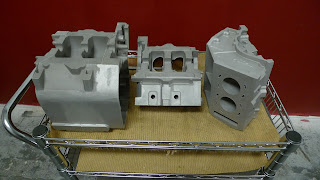We left off on the crankshafts with all the lathe operations being complete and all 4 parts being ready for the 4 axis mill work.
The next operation is to do the offset machining needed for the connecting rod journals. There are two techniques available: eccentrically mount the crankshaft in a special chuck on the connecting rod axis and turn the journal or mount the crankshaft on the main journals and eccentrically turn the conrod journal. The first option is easier to program but more difficult to fixture, is very unbalanced during machining, and requires part repositioning for each conrod throw. The 2nd option is more complicated from a programming perspective but is easier to fixture, is balanced, and needs no part repositioning. I chose the 2nd option as once the upfront programming work is done making multiples is easy and repeatable.
Due to the low cutting forces due to the aluminum test part material and a desire to get a sample part machined I opted to leave the outboard 4th axis support off. Machine time these days is limited and getting a sample part quickly was of prime importance.
The mill setup is as shown:
The first operations are simple pocketing to remove the majority of the material in the most efficient machining technique. Pocketing was done at increments of 90 degrees and ended up with squarish journals.
Once this stage was complete I moved on to the 2nd program which created the fully round journals. The video of this move is subtle but cool. The machine is performing a G3 arc in the YZ plane (G19) while the 4th axis is doing a rotary move from 0 to 360 degrees. The result is an eccentric true cylindrical surface with none of the approximation concerns usually associated with surface machining type toolpaths.
This is the first journal after its finishing pass.
And this is a short movie of both journals.
The 3 slight ridges on each journal are an artifact of the dished end of the end mill used for the test cut. For the final steel parts I had a 4 flute finishing end mill specially modified to flatten the end face and keep it center cutting. It is not suitable for machining aluminum so in the interest of quickly getting a verified program I used a mill with standard aluminum cutting end geometry.
This part is being sent to a grinding house for finishing of the journals so the absolute tolerance and surface finish are not as crucial as long as there is enough stock left to clean up during grinding. After consulting with the grinder I am leaving .010" of stock on the main journals and .020" on the connecting rod journals as grinding allowance.
Now that I have a sample crankshaft we can test assemble a short block with the major rotating components: crank, conrods, pistons, and also trans and oil pump/drive components. Once we reach that stage there will be lots of pictures!
That's all for now.
Chris







































































